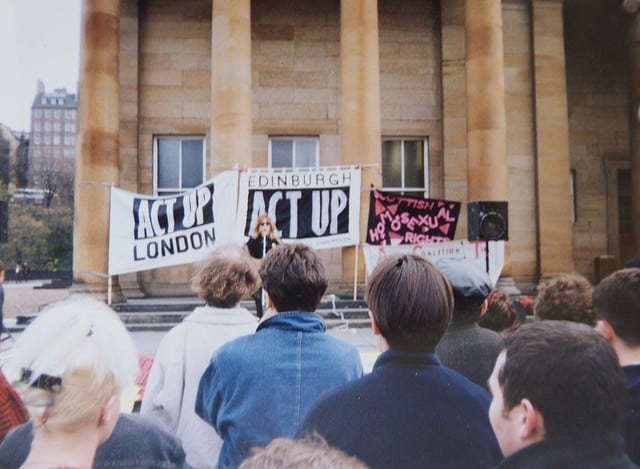Imagine a world where your community is in the grip of a deadly new disease. This virus is mysterious, 100% fatal, and targets specific groups of people. Instead of receiving compassion from the government or neighboring communities, others ignore your plight or even react with anger towards the infected.
This was the terrifying reality for people living with the Acquired Immunodeficiency Virus (AIDS) virus less than 20 years ago. A newly released documentary How to Survive a Plague, nominated for the Academy Award for Best Documentary at the upcoming Oscar Ceremony, captures both the joy and terror of those days, and the epic day-by-day battles that finally made AIDS survival possible.
Background
The film opens in 1987, year six of the AIDS epidemic. The “epicenter” of the plague was Greenwich Village, New York City, also one of the largest and most vibrant LGBT communities in North America. During this time, there were no drugs to treat the Human Immunodeficiency Virus (HIV), or the resulting AIDS which often followed the diagnosis of HIV. Hearing “you’ve tested positive for HIV/AIDS” was the same as “you are hereby sentenced to death.” Generally, it took less than two years for the disease to finish its victims.
Even as knowledge of the deadly disease increased, there was still little hope for the infected. The first U.S. government-approved drug to treat AIDS, AZT, was rife with problems. Costs of AZT were around $10,000 a year, far too much for the majority of AIDS patients. The drug was also highly toxic and could not be tolerated by more than half of AIDS victims.
Further, there was also the social stigma that came with having AIDS. Anti-gay/lesbian violence skyrocketed. Hospitals and funeral homes often refused to serve people with AIDS. The AIDS community even had to deal with politicians spouting anti-gay rhetoric on the Senate floor.
Rise of Activism
However, those who were infected refused to suffer in silence. Mr. France documents the formation and rise of ACT UP (AIDS Coalition to Unleash Power) and TAG (Treatment Action Group). These groups sought to empower HIV/AIDS victims, spread awareness of their plight, and demand government action for healthcare rights.
Activists vigorously protested anywhere they could get publicity. ACT UP’s first protest was in front of the New York Stock Exchange in Manhattan on March 24, 1987. The group hoped to draw media coverage to the Ed Koch administration’s lack of attention to the crisis. In one protest in front of the FDA offices in Rockville, Maryland, activists blocked the entrances to the building in protest of what they viewed as inaction by the government.
During an FDA committee hearing about testing experimental drugs, protestors in the audience held out their watches as a symbol of how people were dying from AIDS every minute while the committee was busy debating. In the words of one ACT UP protester, “the reason we are doing this (demonstrating) is because the government has the resources to deal with the AIDS epidemic and they won’t do it unless we force them.”
Physicians
In attempting to treat AIDS, physicians took matters into their own hands. Going against government regulations, doctors united with activist groups developed and experimented with drugs to treat the HIV/AIDS virus. They also experimented with ways of treating the “opportunistic infections” that resulted from living with the disease, such as pneumonia and cancer.
Some physicians even went so far as to illegally import AIDS-treatment drugs that had been developed in Europe and Japan. Although these doctors risked arrest, losing their medical licenses, public disgrace, and federal prison if caught, they viewed treating AIDS patients as a higher calling that went beyond the law.
Outcome
During the mid-1990’s, the AIDS community was able to make massive strides in making AIDS a survivable condition. Pharmaceutical companies developed a series of powerful virus suppressants that were extremely effective in test subjects. Activist groups were able to convince the FDA to run accelerated, patient-focused tests and the first drugs were approved for public use after only 6 months of trials. Today 7 different companies make AIDS suppressing drugs and nearly 6 million lives have been saved worldwide.
How to Survive a Plague is an inspiring tale of persistence and courage. David France vividly captures the heartbreak, the struggle, and the triumph of the AIDS community. The efforts of ACT UP, TAG, and similar groups, through selfless sacrifice, were able to get the sick and dying the care that their own governments denied them. Although HIV is no longer the death sentence it once was, there is still much that needs to be done. ACT UP’s fight will continue until AIDS has been wiped from the face of the Earth.
Want more? Check out this clip of gay rights activist Peter Staley and host Anderson Cooper discussing the documentary on Anderson Live:
Photo by Stuart Grout

